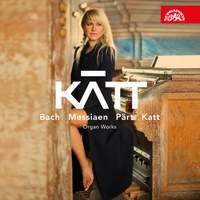Interview,
Katt - Organ Works
 Our thanks to Supraphon and their UK distributor RSK for kind permission to share this interview with Katerina Chroboková, whose disc of Bach, Messiaen, & Pärt (plus her own improvisations) was released last month.
Our thanks to Supraphon and their UK distributor RSK for kind permission to share this interview with Katerina Chroboková, whose disc of Bach, Messiaen, & Pärt (plus her own improvisations) was released last month.
A distinguished Czech organist and harpsichordist, Kateřina Chroboková has gained recognition at home and abroad alike, and of late has also drawn attention as a composer. Her album KATT presents her as a superlative performer of music by J. S. Bach, Arvo Pärt and Oliver Messiaen, as well as her own pieces. The disc is unique in terms of the repertoire, interconnecting the individual works through their spiritual focus, while at the same time being multi-genre, featuring music of a variety of styles, eras and forms, including the artist’s singing on her own compositions. It was recorded on the four-manual organ in Echternach, Luxembourg.
What makes the organ at the Echternach Abbey basilica so special?
I was seeking a suitable instrument on which I could play a wide repertoire spectrum, since, in addition to the Johann Sebastian Bach works, the album contains pieces by Arvo Pärt and Olivier Messiaen. I consider Messiaen a true musical wizard who made use of an enormous range of timbres and registers. Accordingly, I bore in mind that the organ to be used for the recording had to be large and possess intriguing sonic properties that would allow for highlighting the qualities of all the pieces – Messiaen’s, Pärt’s, and mine as well. As an organist, I strive, similarly to these composers, to make use of the immense range of sounds the organ can produce. That is why I opted for the organ in Echternach.
You often say – and your performances serve as proof of it – that you aim to promote the organ as such. Do you think that the 20th- and 21st-century music to which you have considerably devoted is suitable for this purpose?
I am of the opinion that the promotion must be done more within a context than only by means of specific compositions. Hence, I strive to captivate the listener by, on the one hand, an unusual repertoire – both as regards concerts and CDs – and, on the other, by presenting individual works in an uncommon context. Especially when I have my mobile instrument with me. I would also like to address the listeners who are not familiar with that instrument.
Could you give us an example?
Bach, for instance, was a genius, with his works splendidly promoting the organ. I deem him the spiritual father of organ music. Yet I also think that promotion is more effective when I present it in a different, novel manner, in different connections, such as by means of juxtaposing it with contrastive pieces or combining it with other artistic forms or multimedia. I really liked the projects I saw during my studies in the Netherlands. My professor, Reitze Smits, for instance, created a performance of this type with the renowned contemporary dance company Rosas. He played some Bach works and the dancers improvised to the music.
Has the organ been experiencing a renaissance of late?
The organ has indeed been paid increased attention to, yet, all the same, it could be greater. While I was still studying in the Netherlands, I tried to motivate a few composers to write organ pieces for me. At the time, composers from all over the world had gathered there and were also at the school I attended. So, composers from Mexico, Indonesia and Greece, for instance, created music for me. Yet, at the same time, I would encounter composers who were afraid of the organ, many of them holding the instrument in a sort of awe. Many have created audacious works for all kinds of instruments, yet whenever they face the organ, they are very conservative. And they explained that their attitude was due to this very awe. As an organist, I am well acquainted with the variety of possibilities and the potential the instrument possesses. I kept on doing my best to show this to the composers, urging them to try this or that ... So much so that I ultimately ended up starting to write music myself.
Some passages of your compositions come across as being the fruit of improvisation. Is my impression right?
Yes, it basically is. All my original pieces actually started with improvisation. One day, I arrived at the church in Slavkov, where I was scheduled to give a concert, and spontaneously began to improvise. A possible reason was that the organ there had so enthralled me, its timbre in particular.
I remember that the tone quality was unusual, the instrument hardly sounded like an organ, rather being reminiscent of a flute, something like the Pan flute. And the other organ pipes sounded like a Celtic instrument. I found it all absolutely fascinating, so I just plunged into improvisation there and then. And at that moment, I realised that I really enjoyed it, that all of a sudden I had begun creating my own music. It was a true epiphany for me. So my very first piece was the result of improvisation. Subsequently, I remade the score, recasting it into its definite form. This very first work of mine is featured, under the name of Slavkof, on the KATT album.
What inspires you?
It’s a continuous process; I’m surrounded by plenty of stimuli. I can be inspired by interesting people, intriguing music or instruments too. A specific instrument, its timbre, often serves to inspire me, and then I start to improvise, remember certain motifs, which thus gives rise to a new composition.
KATT was released on 18th March on Supraphon.
Available Formats: MP3, FLAC



